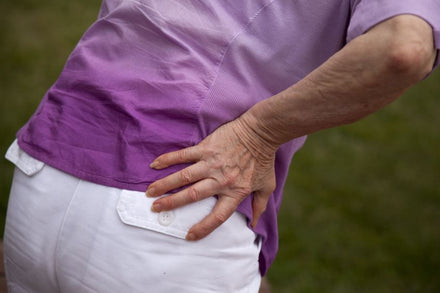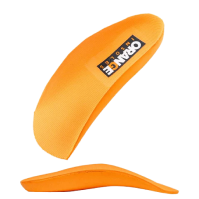
Hip Pain
Symptoms
- Pain along the lateral (outside) of the hip
- Pain when ascending stairs and/or getting up from a seated position
- Pain associated with standing for long periods or for sitting forextended periods
- May have trouble sleeping
- May have limited range of motion of the hip
Definition
Siliotibial Band Syndrome
- An inflammation where the band rubs across the distal (lower portion)lateral femur
- Pain is felt along the outer side of the hip and also possibly the knee
Trochanteric Bursitis
- Inflammation of the bursa along the outside of the hip
- Mechanical imbalance in the lower extremity due to poor foot mechanics
Piriformis Syndrome
- A spasm or tightness of the piriformis muscle in the buttocks that can irritate the sciatic nerve or impingethe sciatic nerve
- May be caused by poor mechanics of the foot and lower extremity
Hamstring Strain
- A muscle imbalance or overload of the hamstring muscle which strains the muscle
- Pain is located either in the buttocks or in the “belly” of the muscle in the back of the thigh
- May feel tear or pop in severe cases
Hip Flexor Strain
- Overload or overuse of the muscle in front of thigh and hip such as climbing stairs, marching or uphillrunning
- There may be a limp and shortened stride
- Mechanical imbalance in lower extremity
Excessive Pronation
- Pronation (a flattening of the arch) is a normal movement of the foot that helps the body to absorb shockand to adapt to different ground surfaces.
- In analyzing ones gait, first contact is on the heel and outside of the foot; followed by a shift of bodyweight continuing forward, toward the arch and toes.
- If the foot is weak or tired and/or the footwear is not supportive, then the arch can flatten more thannormal, which is excessive pronation.
- If the pronation becomes excessive, there is increased rotation of the leg, knee, thigh and hip, causingadded stresses to the joint.
- Flattening of the arch too much (excessive pronation) places pressure on the arch, and on up the chain including the ankle, knee and hip.
Contributing Factors
- Poor flexibility
- Muscle imbalances
- Leg length discrepancies
- Tightness of IT Band/Tensor Fascia Latae
- Flattened pronated feet
- Poor support of shoes you wear and /or the support inside the shoes can add to the stress on the foot andlower extremity
- Biomechanical changes in the foot can allow increases in pronation
- Many foot injuries are caused by overpronation
Treatment - Advice Given Most In Current Literature
The 3S’s — Stretching, Strengthening and Supporting, along with ICE and REST, have been found tobe the simplest and most effective treatment for these injuries.
- Stretching of the IT Band, Hamstring, Quad, and Psoas Major can help to decrease and eliminate many of the problems.
- Strengthening of the muscles of the abdomen, quad and hip can assist in avoiding problems.
- Supporting the foot with proper shoes and insoles can prevent or eliminate the vast majority of stresses on the lower extremity. This may be a Birkenstock sandal with a broad base and contoured footbed that is low to the ground and conforms to the foot. It may also be a shoe with an upper that wraps the foot and supports the arch and heel, thus limiting excessive pronation. The vast majority of footwear have more than enough cushion but very little support for the arch and heel. One of the easiest and most effective solutions is to add a simple over the counter insole that provides a forgiving support for both the arch and heel. Orange Insoles has got you covered with our shoe inserts for hip pain.
Not sure what insole is right for you? Take the Insole Quiz!





